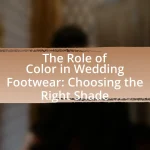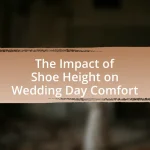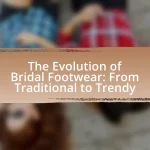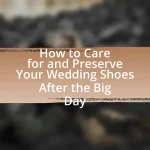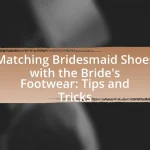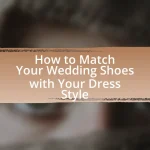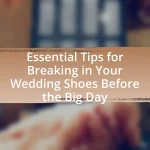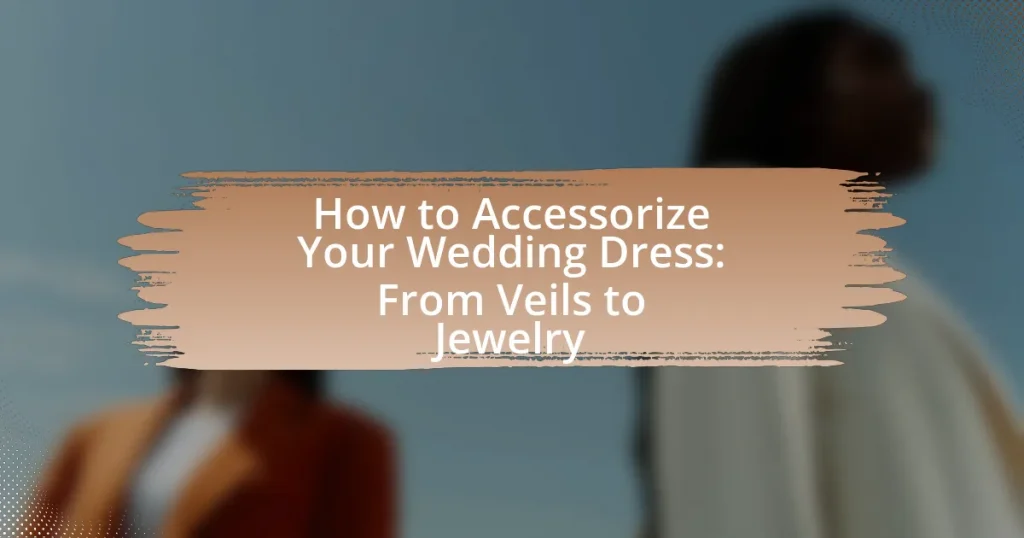The article focuses on essential accessories for wedding dresses, including veils, jewelry, shoes, and bouquets, highlighting their significance in enhancing the bride’s overall appearance. It discusses how veils add elegance and tradition, the various types of veils available, and how to choose the right length to complement the dress. Additionally, it covers the role of jewelry in accessorizing, popular types for brides, and tips for matching jewelry with dress styles. The importance of hair accessories and how to select them based on hairstyle is also addressed, along with factors to consider when coordinating accessories with the wedding dress. Common mistakes to avoid and best practices for achieving balance in accessory choices are outlined, ensuring a cohesive and elegant bridal look.
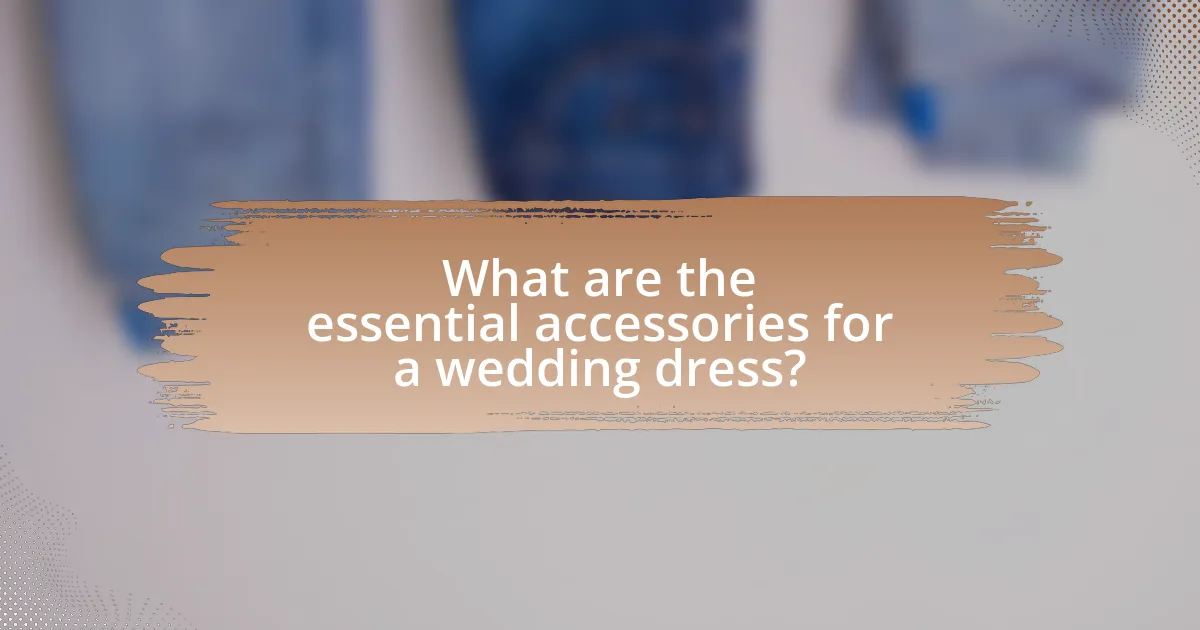
What are the essential accessories for a wedding dress?
The essential accessories for a wedding dress include a veil, jewelry, shoes, and a bouquet. A veil adds elegance and tradition, often symbolizing purity, while jewelry such as earrings, necklaces, and bracelets enhances the overall look and can complement the dress’s design. Shoes are crucial for comfort and style, as they complete the outfit and should match the wedding theme. A bouquet not only serves as a beautiful accessory but also plays a significant role in the wedding ceremony and photographs. Each of these accessories contributes to the bride’s overall appearance and can be tailored to fit personal style and wedding aesthetics.
How do veils enhance the overall look of a wedding dress?
Veils enhance the overall look of a wedding dress by adding elegance and a sense of tradition. The delicate fabric of a veil can soften the silhouette of the dress, creating a romantic and ethereal appearance. Additionally, veils can complement the dress’s design elements, such as lace or embroidery, by framing the face and drawing attention to the bride’s features. Historical context shows that veils have been worn in weddings for centuries, symbolizing modesty and purity, which further enriches their significance in modern ceremonies.
What types of veils are available for brides?
Brides have several types of veils available to choose from, including cathedral, chapel, fingertip, elbow, and birdcage veils. Cathedral veils are the longest, trailing several feet behind the bride, while chapel veils are slightly shorter, typically reaching the floor. Fingertip veils extend to the bride’s fingertips, elbow veils reach the elbows, and birdcage veils are short and often cover the face. Each type of veil serves different aesthetic preferences and can complement various wedding dress styles, making them versatile accessories for brides on their special day.
How do you choose the right veil length for your dress?
To choose the right veil length for your dress, consider the style and silhouette of the gown. A fingertip veil complements a fitted dress, while a cathedral veil suits a more dramatic, flowing gown. The length should enhance the overall look without overwhelming it. For example, a knee-length veil works well with tea-length dresses, while a long veil can add elegance to a ball gown. Matching the veil length to the dress style ensures a cohesive appearance, as supported by bridal fashion guidelines that emphasize harmony between accessories and attire.
What role does jewelry play in accessorizing a wedding dress?
Jewelry plays a crucial role in accessorizing a wedding dress by enhancing the overall aesthetic and personal style of the bride. The right pieces, such as necklaces, earrings, and bracelets, can complement the dress’s design, adding elegance and sophistication. For instance, a statement necklace can draw attention to the neckline, while delicate earrings can frame the face beautifully. Additionally, jewelry can incorporate personal significance, such as heirloom pieces, which add emotional value to the bridal look. Studies in fashion indicate that accessorizing can elevate an outfit’s perceived value, making jewelry an essential element in creating a cohesive and memorable bridal ensemble.
Which types of jewelry are most popular for brides?
The most popular types of jewelry for brides include engagement rings, wedding bands, earrings, necklaces, and bracelets. Engagement rings are often the centerpiece, symbolizing commitment, while wedding bands complement them, typically featuring simple designs or matching styles. Earrings, such as studs or drop styles, enhance the bride’s overall look, and necklaces can range from delicate chains to statement pieces, often chosen to complement the neckline of the wedding dress. Bracelets, including bangles or cuffs, add elegance and can be personalized with charms or engravings. These choices reflect current trends and traditional preferences, ensuring brides feel beautiful on their special day.
How can you match jewelry with your wedding dress style?
To match jewelry with your wedding dress style, first identify the dress’s design elements, such as its neckline, fabric, and embellishments. For example, a strapless gown pairs well with statement necklaces, while a high-neck dress may require simpler earrings. Additionally, consider the overall theme of the wedding; vintage dresses often look best with antique-style jewelry, while modern gowns can be complemented with sleek, contemporary pieces. This approach ensures that the jewelry enhances the dress without overwhelming it, creating a cohesive look for the bride.
Why are hair accessories important for a bridal look?
Hair accessories are important for a bridal look because they enhance the overall aesthetic and complement the wedding dress. These accessories, such as veils, tiaras, and hairpins, serve to unify the bridal ensemble, adding elegance and personal style. For instance, a well-chosen veil can frame the face and create a romantic appearance, while a tiara can add a touch of royalty and sophistication. Additionally, hair accessories can reflect the wedding theme and the bride’s personality, making them a crucial element in achieving a cohesive and memorable bridal look.
What types of hair accessories can complement a wedding dress?
Hair accessories that can complement a wedding dress include veils, tiaras, hairpins, and combs. Veils add a traditional touch and can vary in length and style, enhancing the overall bridal look. Tiaras provide a regal appearance and can be adorned with crystals or pearls, aligning with the elegance of many wedding dresses. Hairpins and combs, often embellished with flowers or jewels, can be strategically placed to add subtle sparkle and detail, harmonizing with the dress’s design. These accessories not only enhance the bride’s hairstyle but also contribute to the overall aesthetic of the wedding ensemble.
How do you select the right hair accessory for your hairstyle?
To select the right hair accessory for your hairstyle, first consider the style and shape of your hair. For instance, if you have an updo, a decorative hairpin or comb can enhance the look, while loose waves may pair well with a floral crown or headband. Additionally, the accessory should complement your wedding dress; for example, if your dress has intricate beading, choose a simpler accessory to avoid clashing. The right accessory should also match the overall theme of your wedding, whether it’s rustic, elegant, or bohemian, ensuring a cohesive appearance.
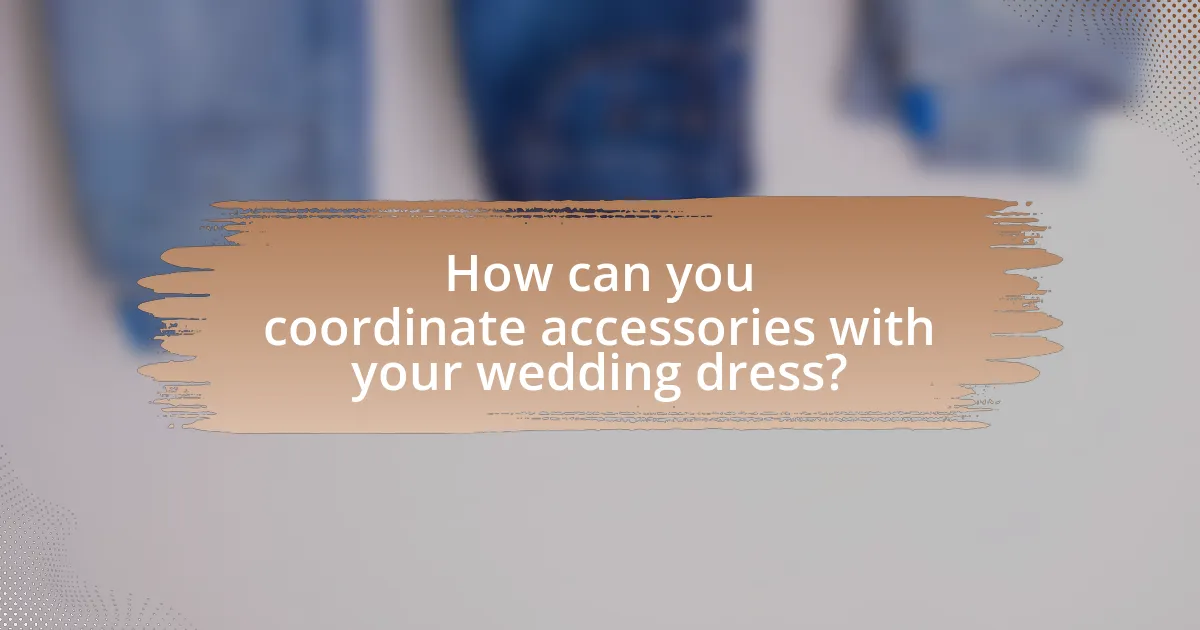
How can you coordinate accessories with your wedding dress?
To coordinate accessories with your wedding dress, select pieces that complement the dress’s style, color, and fabric. For instance, if your dress is intricate with lace details, opt for simpler accessories to avoid overwhelming the look. Additionally, consider the neckline of the dress; a strapless gown pairs well with statement necklaces, while a high neckline may benefit from earrings instead. Color coordination is also crucial; accessories should either match or harmonize with the dress color, enhancing the overall aesthetic. For example, if the dress is ivory, gold or pearl accessories can create a cohesive look. This approach ensures that the accessories enhance rather than distract from the wedding dress, creating a balanced and elegant appearance.
What factors should you consider when choosing accessories?
When choosing accessories for a wedding dress, consider the style of the dress, the overall theme of the wedding, and personal comfort. The style of the dress dictates which accessories will complement it; for example, a vintage dress pairs well with antique jewelry, while a modern gown may suit sleek, contemporary pieces. The wedding theme influences accessory choices, as a beach wedding might call for lighter, more casual items, whereas a formal event may require more elegant accessories. Personal comfort is crucial, as accessories should not hinder movement or cause discomfort throughout the day. These factors ensure that the chosen accessories enhance the overall look and feel of the wedding attire.
How does the dress style influence accessory choices?
The dress style significantly influences accessory choices by dictating the overall aesthetic and formality of the look. For instance, a classic A-line wedding dress typically pairs well with understated accessories like simple pearl earrings and a delicate veil, enhancing its timeless elegance. In contrast, a modern, structured gown may call for bold statement pieces, such as oversized earrings or a dramatic necklace, to complement its contemporary design. This relationship is supported by fashion principles that emphasize harmony between clothing and accessories, ensuring that the overall appearance is cohesive and visually appealing.
What color schemes work best for wedding accessories?
Neutral color schemes, such as ivory, beige, and soft pastels, work best for wedding accessories. These colors complement a wide range of wedding dresses and create an elegant, cohesive look. Additionally, metallics like gold, silver, and rose gold are popular choices, as they add a touch of glamour and can easily coordinate with various color palettes. According to wedding industry experts, these color schemes enhance the overall aesthetic without overpowering the bride’s gown, ensuring that accessories harmonize with the wedding theme.
How can you personalize your wedding dress accessories?
You can personalize your wedding dress accessories by selecting items that reflect your personal style and story. This includes choosing unique jewelry, such as custom-made pieces or heirlooms, selecting veils or headpieces that incorporate personal elements like family traditions or favorite colors, and opting for shoes that match your personality, whether they are classic, modern, or whimsical. Personalization can also involve adding custom embroidery or embellishments to accessories, ensuring they resonate with your individual aesthetic and the overall theme of your wedding.
What unique accessories can reflect your personality?
Unique accessories that can reflect your personality include personalized jewelry, statement veils, and custom hairpieces. Personalized jewelry, such as engraved necklaces or bracelets, showcases individual style and meaningful connections. Statement veils, featuring unique embellishments or colors, can express personal taste and creativity. Custom hairpieces, like floral crowns or vintage clips, allow for a distinctive touch that aligns with one’s aesthetic. These accessories not only enhance the overall look but also serve as a representation of personal identity on a significant occasion.
How can family heirlooms be incorporated into your accessories?
Family heirlooms can be incorporated into your accessories by transforming them into unique pieces that complement your wedding dress. For example, a vintage brooch can be attached to a bouquet or a family necklace can be worn as a statement piece. This practice not only adds sentimental value but also creates a personalized touch to your overall look. Historical trends show that many brides choose to wear something borrowed, often including family heirlooms, which enhances the emotional significance of the occasion.

What are some common mistakes to avoid when accessorizing a wedding dress?
Common mistakes to avoid when accessorizing a wedding dress include over-accessorizing, mismatching styles, and neglecting the dress’s neckline. Over-accessorizing can overwhelm the overall look; for instance, pairing a heavily embellished dress with bold jewelry can create visual clutter. Mismatching styles, such as combining vintage accessories with a modern gown, can disrupt the aesthetic harmony. Additionally, neglecting the neckline can lead to poor accessory choices; for example, a high-neck dress may not pair well with a statement necklace, making it essential to consider how accessories complement the dress’s design.
How can over-accessorizing detract from your wedding dress?
Over-accessorizing can detract from your wedding dress by overwhelming its design and drawing attention away from the gown itself. When a bride adds too many accessories, such as excessive jewelry, multiple hairpieces, or elaborate veils, it can create a cluttered look that competes with the dress’s elegance. For instance, a simple, classic wedding dress may be overshadowed by bold statement pieces, leading to a visual imbalance. This phenomenon is supported by fashion principles that emphasize the importance of harmony and balance in styling, where less is often more for achieving a refined appearance.
What signs indicate that you have too many accessories?
Signs that indicate you have too many accessories include feeling overwhelmed when choosing what to wear, receiving comments from others about your look being too busy, and noticing that your accessories clash rather than complement each other. Additionally, if you find it difficult to store or organize your accessories due to their quantity, this is a clear sign of excess. Research shows that a cluttered appearance can detract from the overall aesthetic, making it essential to maintain a balanced approach to accessorizing, especially for significant events like weddings.
How can you achieve balance in your accessory choices?
To achieve balance in your accessory choices, select pieces that complement rather than overwhelm your wedding dress. For instance, if your dress features intricate detailing, opt for simpler accessories like understated earrings or a delicate bracelet to maintain harmony. Conversely, if your dress is minimalist, you can enhance your look with bolder accessories, such as statement necklaces or elaborate veils. This approach ensures that each accessory enhances your overall appearance without competing for attention, creating a cohesive and elegant look for your wedding day.
What tips can help you successfully accessorize your wedding dress?
To successfully accessorize your wedding dress, choose accessories that complement the style and fabric of the dress. For example, if your dress is intricate, opt for simpler accessories to avoid overwhelming the look. Additionally, consider the neckline of your dress; a strapless gown pairs well with statement necklaces, while a high neckline may benefit from earrings or a hairpiece. Furthermore, ensure that the color palette of your accessories aligns with the overall theme of your wedding, as this creates a cohesive appearance. According to bridal fashion experts, balancing the scale of accessories with the dress’s silhouette is crucial; larger dresses can handle bolder accessories, while more fitted styles may require delicate pieces.
How can you ensure your accessories are comfortable for the day?
To ensure your accessories are comfortable for the day, select items that are lightweight and adjustable. For instance, choose earrings made from hypoallergenic materials to prevent irritation and opt for a veil that is not too heavy or long, allowing for ease of movement. Research indicates that wearing accessories that fit well and are made from breathable materials significantly enhances comfort throughout the day, as confirmed by studies on garment comfort and wearability.
What are the best practices for coordinating accessories with your bridal party?
The best practices for coordinating accessories with your bridal party include selecting a cohesive color palette, ensuring complementary styles, and considering the overall wedding theme. A cohesive color palette allows all accessories to harmonize visually, while complementary styles ensure that each member’s accessories enhance their individual looks without clashing. Additionally, aligning accessories with the wedding theme—whether it’s rustic, modern, or vintage—creates a unified aesthetic. Research indicates that coordinated accessories can enhance the overall visual impact of wedding photos, making this practice essential for a polished appearance.

